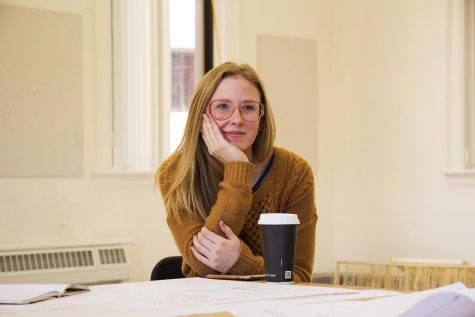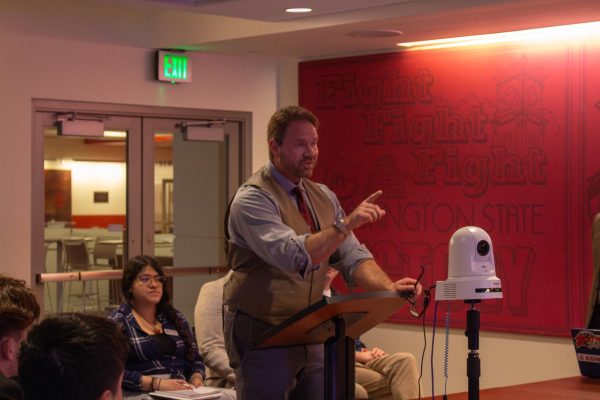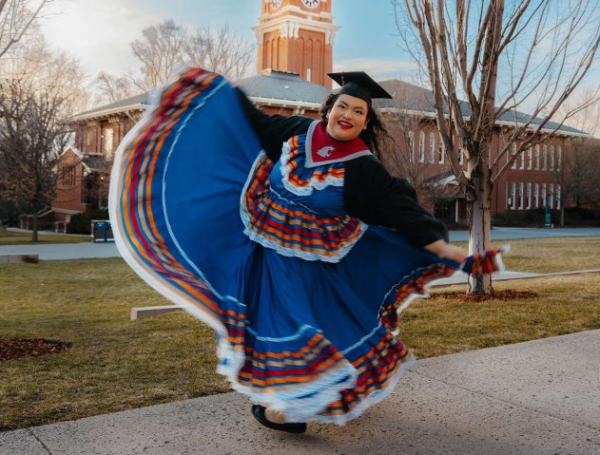Students lead bear facility redesign efforts
From various departments, students redesign, fundraise for new research facility
TEVA MAYER | The Daily Evergreen
Willow, one of the WSU Bear Center’s 2-year-old bears, roams the 2-acre yard. New facility designs aim to incorporate a three yard model, two at 4-acres and one 10-acre, to allow for 24 hour outdoor access.
October 23, 2017
A class of third-year interior design students has been tasked with developing conceptual ideas for a new WSU Grizzly Bear Research, Education and Conservation Center as part of their studio curriculum.
The current facility, which was originally constructed for primate research in the 1950s, has been deemed inadequate by students, faculty and review committees for several years. According to the WSU Bear Center website, it remains the premier grizzly bear research facility in the country, and the only one of its kind.
Aspen Durand, a senior wildlife ecology student, and her friend Daniel Molina, a recent forestry graduate, have been working toward raising awareness and funds for a new bear center for a year and a half. Durand had spent two and a half years as a volunteer at the facility.
“We were just both really upset about it at the same time and we were just like, ‘We should do something about this,’” Durand recalled. “From that day on we’ve been working on this project. We just kind of got each other stoked and kept it rolling.”
She approached the School of Design and Construction last spring with the idea to incorporate the concept plans into its curriculum. Kathleen Ryan, a clinical assistant professor of interior design, decided to take on the project for her class of about 25 students.
Durand explained that she and other wildlife and biology students would work with the interior design students to develop the plans.
“We’re gonna split up into groups,” she said, “and the environmental side of things will be like ‘Oh yeah that’ll work, or won’t work.’ ”
Durand said her and Molina’s overall goal is to raise awareness and collect donations for the bear center. With the recent establishment of a GoFundMe page to augment the “Help the WSU Bears” Facebook presence, they’ve raised $720 since Wednesday. They estimate they will need $20 million for a new facility.
“We’re just trying to get some [donations] from anyone at this point,” Durand said.
Charles Robbins, the director of the WSU Bear Center, emphasized how the research on ecology, conservation and physiology of these captive bears generates information that can’t be retrieved from wild specimens. The detailed and controlled studies conducted at the center are integral to understanding and managing wild populations of grizzlies, he said.
The ongoing energetics study has aided researchers at Yellowstone National Park in their own investigations of grizzly bear stress physiology. The bears have also been used in studies conducted by the Smithsonian, the San Diego Zoo and the Denver Zoo, as well as the University of Maine and Texas A&M, he said.

Aspen Durand, senior wildlife ecology student and a leader of “Help the WSU Bears,” listens to design concepts for a new WSU Bear Center on Friday.
However, Robbins said, the facility limits the number of animals that can be housed and the amount of research conducted.
“We’re really constrained,” Robbins said. “Some of our projects take multiple years, when if we had actual facilities it’d take a year to do … There are a lot of studies we just haven’t done because we don’t have adequate bears and adequate facilities.”
Despite this being the most high-profile and public WSU research facility, Robbins said he has yet to see the administration commit to renovating the center.
He added that the cross-disciplinary work of the students is a good learning experience, as they consider real life problems, but he does not think anything concrete will come from their efforts. However, he agrees with the students that the bears need better facilities.
“The biggest thing is just increasing the bears’ welfare,” Durand said. “A lot of people think, ‘Ya know, the bears … they’re not hungry, they’re fine, they’re protected.’ But there’s so much more to it than that, like mental stimulation. It decreases stress, it increases happiness, and even from that we’d get better research, because the bears are healthy and happy.”
Both she and Robbins explained the importance of giving the bears three outside yards, instead of the 2-acre lot they currently have access to.
“The bears would have almost 24-hour access to going outside and inside, which they desperately need right now,” Durand said.
She added that increasing den and door sizes would allow more space per bear and ease back strain.
Krisandrah Crall, a first year architecture graduate student and the teacher’s assistant for Ryan’s interior design studio class, said the students have kept this in mind as they’ve begun developing concept plans and site maps, the final versions of which could be used as visual aids for future donor outreach.
“People tend to be a little more willing to donate or contribute, or be more excited when they have a visual aid of what it could potentially be,” she said.
The interdisciplinary nature of the project has created opportunities for wildlife ecology, landscape architecture, zoology and interior design students to work together.
The group will discuss topics like the topography of the site, how much natural sunlight each yard would receive per day each season, what natural vegetation to use in landscaping, and how best to provide the bears with the most humane and stimulating environment possible.
Emphasis is also placed on visitor engagement and education outreach, with potential plans for a museum and observation deck to be incorporated into many students’ current work.
“They’re really trying to get people to connect with these bears, because you can’t now,” Durand said.
Such an undertaking is not foreign to the School of Design and Construction, Crall said.
“Looking at this project holistically from all these different points of view … is something that we have been trying to pursue,” Crall said. “All of the design professions are so involved with integration and collaboration.”
She added that she was jealous her own professors didn’t decide to pick up the project.
“I’m a little disappointed that my professor didn’t choose to jump on and have us do this,” Crall said, “because this would be such a cool project … I’m just really impressed that they’re doing it.”
Durand is similarly enthusiastic about the cross-disciplinary potential for such an undertaking.
Toward the end of the most recent cross-disciplinary bear workshop, Durand sat at a large studio table, surrounded by students and their concept maps of the new facility.
She listened attentively as each student described their vision, interjecting occasionally with a suggestion.
“I think it would probably be better to keep it private, just to give them that extra space,” she said when someone suggested adding a visitor viewing area of den spaces.
Durand said they’ve experienced their fair share of “naysayers” and negative attention from this project, but aren’t looking to cause trouble. They are simply dedicated to doing their part in improving the lives of the bears.
“I just want to see them happy,” Durand said. “I don’t want to leave Pullman knowing that they’re going to be stuck there for the rest of their lives.”





















